How do you use the quantum catapult in Stellaris?
How to use the quantum catapult in Stellaris is more complicated than it might seem, especially if you don’t want to waste your hard-won Alloy. The catapult is one of the best late-game structures, though it comes with a few risks. Using it means giving up one of your fleets for a while, and there’s no guarantee they’ll end up where you want them to anyway.


How do you build the quantum catapult?
The quantum catapult is a late-game megastructure in most cases, though the new Slingshot to the Stars Origin lets you have it right away. You can only choose to build a quantum catapult around a pulsar, and it costs 300 influence and 5,000 Alloy to construct the basic catapult. You’ll need quite a bit more for future upgrades, but it’s definitely worth the resources. The base-level catapult has a high chance of depositing your fleet in the wrong area, and it takes much longer for the process to finish.
Since the catapult’s range is limited initially, it’s best to place them in a fairly central location, if possible. That way, you can still maximize the advantage they offer without having to spend so much Alloy up front.
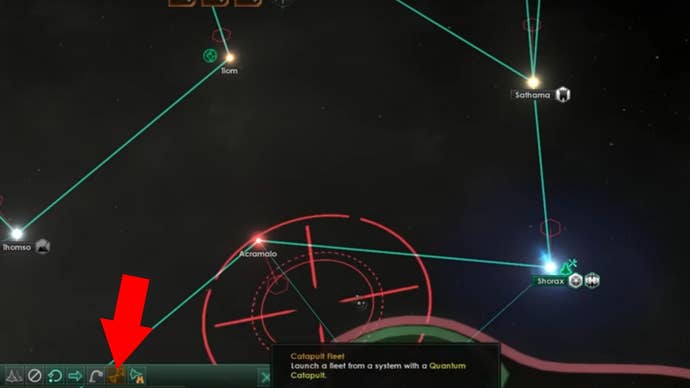
Using the catapult involves a few steps. Put your desired fleet in the catapult, select it, then open the galaxy view. Click the "Catapult Fleet" option from the icon bar. It’s near the jump drive option, second in from the right, though it can be difficult to see given how small the icons are.
Once you’ve clicked it, a new screen opens, showing a broad view of the galaxy with a large circle. The circle is your catapult’s general range, which increases at higher upgrade tiers. Green means the location is within the catapult’s current capabilities, and red is a no go. Make sure to pay attention to the whole circle during your planning, since the end location can be anywhere in it – not just in the center.
Also note how long it will take for the process to complete. At the basic tier, you’ll lose access to that fleet for several days.
While you’re off building megastructures in Stellaris , don’t neglect your vassals. Make them too unhappy, and they might forge a Secret Fealty pact with one of your enemies.
Read this next
- What is Secret Fealty in Stellaris? Subject empire loyalty explained
- Rival gacha game sends in-game mail on Zenless Zone Zero release day that subtly takes shots at HoyoVerse’s similar character designs
- Witcher 3 modder resurrects the boat races CD Projekt cut from the base game, just in case you want to give Roach a break
- Upcoming Games
- Privacy Policy
PC Game Reviews, News, Mods & Videos
Stellaris quantum catapult guide - how do you build and use the quantum catapult.

Stellaris has been going strong for years, but with each new expansion, there’s a whole new set of mechanics that you’ll have to adapt to.
Quantum Catapults were added to the game in the Overlord DLC , but what are they and how do you use them?
Stellaris Quantum Catapult Uses

Quantum Catapults use the power of a star to fling your fleets across the vast emptiness of space, but not just any star will do. The Catapults can only be built in systems with a Neutron or Pulsar star. They, unlike many other Megastructures, can only be built around the star itself.
In many ways, this makes them less useful than the more traditional end-game Gateway network. They take longer for the fleet to arrive at its destination as the fleet enters a missing state until it emerges into real space. Quantum Catapults also suffer from a lack of accuracy, with the fleet essentially being shotgunned across the galaxy.
However, the Catapult has one overriding benefit. It allows fleets to be sent far beyond your borders or into systems where you may not have built an expensive Gateway. In short, you only need one Catapult. Before you can build one though, you need to complete both the Quantum Catapult and Mega Engineering research projects.
If you start your game with a Slingshot to the Stars empire, you will have a dormant Catapult in the home system. Restoring this grants Quantum Catapult research, but you will still need to research Mega Engineering to improve it. If you don’t start with the dormant Catapult but come across one later in your game, you can also restore it, but remember that this requires the Mega Engineering tech.
Improving the Quantum Catapult will confer benefits to Missing in Action time, range, and accuracy. But it should be noted that at higher tiers, constructed Catapults are better than those that have been restored, having a -25%/-50% windup time at stages 2 and 3.
Once you have the Quantum Catapult online, using it is easy. Simply move a fleet into the system with the Catapult - anywhere will do - and click the Catapult Fleet icon in the Fleet Manager window.
This produces a targeting cursor which you can use to designate a target for your fleet. If the target is valid it will turn green, and then you just click and keep your fingers crossed that they appear in the correct place.
Keep updated on the latest PC Gaming news by following GameWatcher on Twitter , checking out our videos on YouTube , or giving us a like on Facebook . Thank you.
Matthew cut his teeth on Age of Empires and never looked back. He misses the times when games still came in boxes...
Featured Stories

Stellaris: How to Use a Quantum Catapult

Your changes have been saved
Email Is sent
Please verify your email address.
You’ve reached your account maximum for followed topics.
Pokemon Fan Shares Four Unique Mega Evolutions
Resident evil and xcom fans should keep an eye on dead season, stardew valley player gets a perfect gift from their cat.
The galaxy is full of mysteries in Stellaris , ranging from the benign to the apocalyptic. In order to steer their fledgling civilization safely across the stars, players will need to constantly develop new technologies to allow them to reach further and faster. However, sooner or later, all explorers and colonizers in Stellaris will eventually run up against a major obstacle, whether it's a hostile empire, a terrifying guardian, or simply a gulf of empty space.
Fortunately, Stellaris ' Overlord DLC introduced a new Megastructure that can allow players to bypass any obstacle and continue exploring and spreading their empire into new Systems. The Quantum Catapult is one of the cheapest Megastructures to build in Stellaris , but players will still need an advanced empire to research it.
RELATED: Stellaris: How to Build a Holding
How to Build a Quantum Catapult in Stellaris
Like most of the Megastructures in Stellaris , the Quantum Catapult cannot be researched until players have completed the Mega-Engineering tech, which in turn requires Zero Point Power, Battleships, and Citadels. Both Mega-Engineering and Quantum Catapults are rare techs, which means that they have a low chance of appearing in Stellaris ' semi-random tech tree unless the player has ruined Megastructures or a large amount of Citadels within their territory.
Once researched, players can use a Construction Ship to build a Quantum Catapult Site in any System that contains a pulsar or neutron star for the cost of 5,000 Alloys and 300 of Stellaris ' all-important Influence . Once the Site is completed, players can upgrade it through four stages, each of which costs 10,000 Alloys. At each stage, the Quantum Catapult will become more accurate and more efficient, allowing players to launch their fleets further and faster across the galaxy.
Alternatively, players who chose the Slingshot to the Stars Stellaris Origin will start the game with a ruined Quantum Catapult in an adjacent System, and can repair it without needing the Mega-Engineering tech. This is the best way to get a functional Quantum Catapult in the early game, allowing players to spread their Empire far without having to reach Mega-Engineering.
How to Use a Quantum Catapult in Stellaris
Once players have constructed a Quantum Catapult Megastructure in Stellaris , they'll be able to use it to launch their fleets or ships to distant star systems , ignoring the normal Hyperlane network. This is done by selecting a fleet in the same System as the Quantum Catapult, and then pressing the new button in the fleet UI to the right of the Jump icon.
Although this propulsion method works a little like a Jump Drive, it comes with a few provisors. The most notable is that the further a Quantum Catapult sends a fleet, the less accurate their launch will be. This can lead to fleets landing in adjacent Systems, or even Systems several jumps away from their intended target. The potential spread of a Quantum Catapult launch is shown by the circular reticle when choosing a target system.
Once a target system has been selected, the Quantum Catapult will take a short time to wind up and then launch the fleet. Based on the level of the Quantum Catapult, the launch wind-up will take longer, and it will also take longer for the fleet to actually arrive at their destination. Once a fleet arrives, they'll receive a +33% fire-rate bonus for 4 months , making the Quantum Catapult a useful tool for surprise attacks to take enemy home worlds .
Stellaris is currently available on PC, macOS, PS4, Xbox One, and Xbox Series X/S.
MORE: Stellaris: How to Form a Mercenary Enclave

How To Use Quantum Catapult In Stellaris
Find out how to use these cosmic slingshot machines to transport your fleets.
Stellaris is a grand-strategy MMO game that involves space exploration of a technologically superior species in a race to conquer the galaxy. This cosmic sandbox game allows players to interact, explore, research, and formulate a strategy for expanding their galactic empire. Transportation being an important part of the cosmic colonization, the game offers you a number of options. Jump Drives are one of the first methods players can use to travel but you soon realize they are not enough. Quantum Catapults are slingshot megastructures that warp space-time to launch your fleet as much as 5 times the distance covered by Jump Drives. So in this guide, we will discuss how you can use Quantum Catapults in Stellaris.
How to Use Quantum Catapults in Stellaris
Firstly, you need to launch the game with the Overlords DLC in which they were introduced. Now although Slingshot to the Stars Origin gives it to you from the get-go, you can also choose to build a Quantum Catapult around a Neutron Star (Pulsar) for 300 Influence and 5000 Alloys. This will be a basic catapult that can be later upgraded for more accurate launches. This is because Quantum Catapults, although better than some other FTL options, still just launches your troops in a general direction near your desired destination.
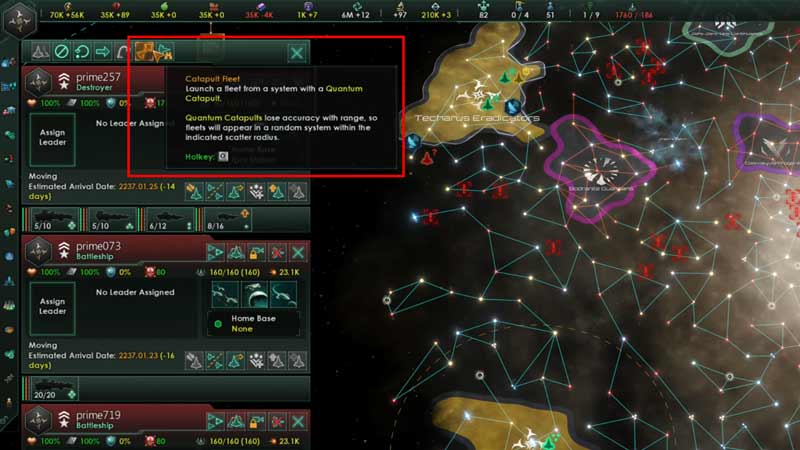
In order to use these megastructures, follow the steps below:
- Select the fleets you wish to launch and plant them in the same star system as your Catapult
- Now, open the Galaxy View and click on the Catapult icon on the bottom left bar.
- You should now see a wider map and a circle to mark the ‘throwing range’ of the catapult. This range can be extended with upgraded catapults.
- Select your desired destination somewhere in the general direction of where you wish to catapult your fleets.
- After a brief charge period, the Quantum Catapult will launch your fleet.
You should also remember to be cautious while using Quantum Catapults to launch your fleets. This is because they are not accurate and sometimes it may end up launching your fleet into a territory with closed borders causing your fleet to go MIA immediately.
That is all there is to using Quantum Catapults in Stellaris. If you found this article helpful check out our other Stellaris guides on GamerTweak.

Kevin is a novel contributor who loves to write about gaming, still in college Kevin always hunts down what is new in the gaming world. In one line he is a "Resident Gamer" who can and most likely will talk about all trivial things in video games. You can reach me at [email protected]
- GT Originals
- AC Valhalla
- Genshin Impact
- Honkai Star Rail
- Street Fighter 6
- Project Slayers

Stellaris How To Use The Quantum Catapult

The Overlord DLC added Quantum Catapults to the game. How do you use them? How do you gain access to them? Are there any advantages to having one? Read on!
To use a Quantum Catapult first move your fleets into the same system as the Quantum Catapult. Go to Galaxy View and select your fleets. A targeting reticule appears. Place it where you want your fleet to go and if it’s green, click on the destination. After a warm-up period the Catapult will “slingshot” your fleets, hopefully somewhat close to the intended destination.
Stellaris Quantum Catapult
A Quantum Catapult “slingshots” fleets across the galaxy by harnessing the power of a star. You don’t need to enter it with your fleets (you can’t anyway), all your fleets need to do to use it is to be in the same system as the catapult. Just click the Catapult Fleet icon at the top of the fleet screen to use it. It’s probably easier go to the Galaxy View and then click the Catapult Fleet icon at the top of the fleet manager. After clicking the Catapult fleet icon, a targeting reticle will appear, a green reticle means everything is ok. Click on the destination and your fleets will on their way shortly after a brief warm-up time for the Quantum Catapult has elapsed.
When you own hyper relays a Quantum Catapult reduces the time spent by a fleet while Missing in Action by a certain percentage depending on the stage of the Catapult.
What Are The Requirements For Building A Quantum Catapult?
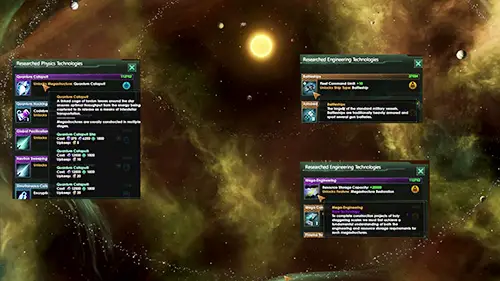
First you must have Maga Engineering technology unlocked and have the ability to build Battleships. After you unlock Mega Engineering, you’ll need to unlock the Quantum Catapult technology when it becomes available.
If you want to have a Quantum Catapult in the early game, then select the Slingshot to the Stars origin when starting a new game. This guarantees that a ruined one will be in a system close by, plus you’ll have the technology to fix it and use it. Another advantage to this origin is that Starbases can be built for 75% less in Influence, a significant reduction. You’ll still need Mega Engineering unlocked to improve the Quantum Catapult.
Since a Quantum Catapult needs an immense amount of power it harnesses the power of a star, and not just any star. It can only be built in a system with either a Pulsar or Neutron Star. Also, it cannot share the system with another Megastructure like a Mega Shipyard.
Quantum Catapult Stages (Not Ruined)
A Quantum Catapult has 3 stages, with each higher stage providing more range, shorter warm-up times, better accuracy, and less time fleets spend Missing in Action.
- It takes a Construction ship to build the site
- Building the site takes 5 years
- Cost is 375 Influence (not Unity) and 6,250 Alloys.
- Upkeep Costs are 5 Energy Credits per month
- Upgrading to stage 1 takes 5 years (no construction ship needed)
- Cost is 12,500 Alloys.
- Upkeep Costs are 10 Energy Credits per month
- 10% reduction in Missing in Action time (if you have Hyper Relays)
- Upgrading to stage 2 takes 5 years (no construction ship needed)
- Upkeep Costs are 20 Energy Credits per month
- 20% reduction in Missing in Action time (if you have Hyper Relays)
- 25% reduction in Catapult warm-up time
- Longer range than stage 1
- Better accuracy than stage 1 (the longer the distance to target the less accurate the targeting becomes)
- Upgrading to stage 3 takes 5 years (no construction ship needed)
- Upkeep Costs are 30 Energy Credits per month
- 30% reduction in Missing in Action time (if you have Hyper Relays)
- 50% reduction in Catapult warm-up time
- Longer range than stage 2
- Better accuracy than stage 2 (the longer the distance to target the less accurate the targeting becomes)
Ruined Quantum Catapult Stages
- Takes 10 Years to restore a Quantum Catapult
- Cost is 2,500 Alloys
- Takes 10 Years to improve a Quantum Catapult
- Cost is 15,000 Alloys
- Upkeep Costs are 40 Energy Credits per month
Is the Quantum Catapult Useful?
Yes. One use could be for bypassing an empire with closed borders that you aren’t at war with so you can attack another one. Accuracy is the biggest problem. Fleets will be scattered when they arrive, making them easy targets if you need the strength of several fleets together to survive and win. If some fleets happen to end up in an empire with closed borders they will immediately warp back home, leaving your remaining fleets possibly exposed due to reduced firepower.
Another use is if a crisis emerges in a distant part of the galaxy, you can get some fleets into the area to help our besieged allies although fleets will still be scattered upon arrival.
A good method to counter the scattering of the Quantum Catapult is Jump Drives or Psi Drives. Jump drives “tear ship-sized holes” in space, provided almost immediate travel between systems although the range is limited. By using jump drives you can quickly reassemble your fleets and prepare for battle.
Stellaris Hyper Relays

Don’t forget to visit my YouTube channel at https://www.youtube.com/channel/UCcWU6qxVisK93h5guKRVtdg
Since I mentioned Hyper Relays in this article, they’re worth a brief mention. Hyper Relays can be constructed after unlocking the Hyper Relay technology. When a network of Hyper Relays is constructed, it enables fleets to travel almost instantly from one sector to another. They’re great for rushing fleets to troubled areas in your empire and if you have an open borders treaty with another empire you can use theirs for travel as well. They take a year to construct and cost 25 Influence, 500 Alloys and 100 Rare Crystals. They can be built in systems with wormholes and gateways, making them an efficient network for getting fleets to remote parts of the Galaxy fast. The drawback is that you need to control both ends of the network, something you don’t have to worry about with a Quantum Catapult.
Rich Gallien
I've always liked board games like chess and PC games, especially space based strategy games, which lead to the creation of this site. I hope you enjoy it as much as I enjoyed creating it and updating it with new games!
Recent Posts
Endless Space 2 Review
Endless Space 2 is a space-based, turn based strategy game. With all the DLC it has 10 empires, 5 regular, 1 advanced, meaning it has at least one unusual game mechanic, and 4 expert empires which...
Learning Stellaris and Endless Space 2, Which is Easier?
Image Courtesy of VidIQ I thought I would compare Endless Space 2 and Stellaris and see which game was easier to learn. This is a spoiler alert so if you want to skip this you can but I’m going...

Stellaris Wiki
Personal tools
Navigation menu, physics research.
The area provides access to several key points, including: additional research capabilities, strategic resources reveal, point-defense & energy weapons, improved FTL capabilities, improved energy production & storage, and more.
- 1 Table usage
- 2 Computing
- 3 Field Manipulation
- 4 Particles
- 5 References
Table usage [ edit | edit source ]
Color indicators: Starter , Acquisition , Rare , Dangerous , Repeatable .
- The table shows the default names/icons of techs. Flavor entry is displayed if accompanied by a change to effects/requirements.
- If a tech has been available as a research option as part of the last choice, then its (total) weight will be halved in the coming choice.
- The table denotes the base cost of a tech. Actual in-game tech cost will scale with difficulty and the empire's size (number of colonized planets and population).
- To research techs of higher tiers it is first needed to acquire 6 techs of the preceding tier.
- Sorting the table by tiers will place all Starter tech at the top and Repeatable end-game tech at the bottom.
- Most icons also double as links. For more information about an unlocked effect (buildings, components, etc.), click on the accompanying icon.
Computing [ edit | edit source ]
Field Manipulation [ edit | edit source ]
Particles [ edit | edit source ]
References [ edit | edit source ].
- External link: Stellaris Tech Tree (Vanilla)
- Potentially outdated
- Game concepts
- Articles with potentially outdated sections
- Pages with unrecognized icon strings
- Play on Paradox technology
- Paradox Forums
- Paradox Wikis
- Join our playtests
- Media contact
- Legal Information
- EU Online Dispute Resolution
- Terms & Policies
- Frequently Asked Questions
- Paradox Interactive corporate website
Gaming Hybrid
Stellaris – how to use the quantum catapult.
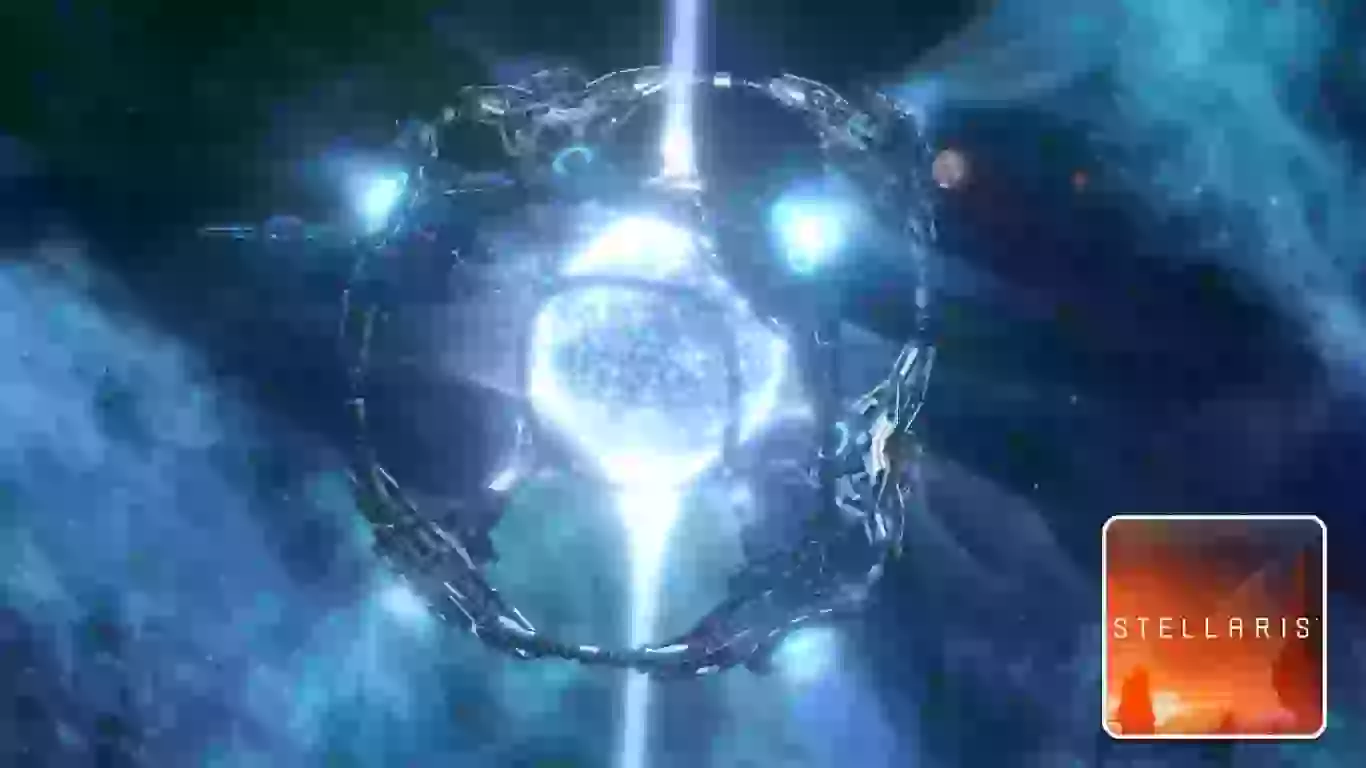
When the Overlord expansion was released in May 2022, a new megastructure called the Quantum Catapult got introduced.
The Quantum Catapult has the power to shoot your ships across the galaxy in a single jump. This is much quicker than traversing the hyperlane network.
Recommended Read: What Is Trade Value in Stellaris?
The tactical advantage this can provide while at war is priceless. Instead of fighting your way to an enemy’s capital, you can deposit a fleet right on top of them.
Using a Quantum Catapult requires a vast investment of research and resources. It will then need constructing around a pulsar or neutron star. When built, you can move your fleets to the system and click the new button on the UI and fire them to where they need to be.
Table of Contents
How to operate the quantum catapult.
Once built, using the Quantum Catapult is as simple as a few button clicks. The complicated part is building it.

How to Build a Quantum Catapult
All mega structures in the game need significant time and resources investment. The catapult is no different, even if it is a little cheaper because it does not cost any unity. Instead, it requires a one-time influence cost.
The first research projects that need completing are; Zero Point Power, Citadels, and Battleships. Once those are complete, you then have a chance to unlock the mega-engineering project. Finally, you have a chance at receiving the physics project called Quantum Catapult.
It is worth noting that Mega-Engineering and Quantum Catapult are rare technologies. As such it could take a long while to roll these projects in the research screen.
Lucky for us, there are ways to improve our chances. The ascension perk Technological Ascendancy can help. It improves your chances of getting rare technologies by 50 percent.
After doing all of that, we can use a construction ship to build the Quantum Catapult build site. Of course, there is another catch. The catapult can only be built in a system that contains a pulsar or neutron star.
While these celestial bodies are not ultra rare, you may not have one in or near your empire’s borders. In which case, you will need to find one to claim or liberate from another empire.
Once you find a suitable site, construction can begin. Creating the first stage of the catapult requires 5000 alloys and 300 influence. The first stage is only a build site and will not give you a working Quantum Catapult yet.
Clicking the site gives us the option to upgrade it to its next stage. This will take 5 years and cost a whopping 10,000 alloys. Once completed, the catapult is operational and ready for use.
Further upgrades can be applied to the catapult two more times. Each upgrade will cost 10,000 alloys and 5 years to complete. The total cost for a fully upgraded Quantum catapult is 35,000 alloys and 300 influence.
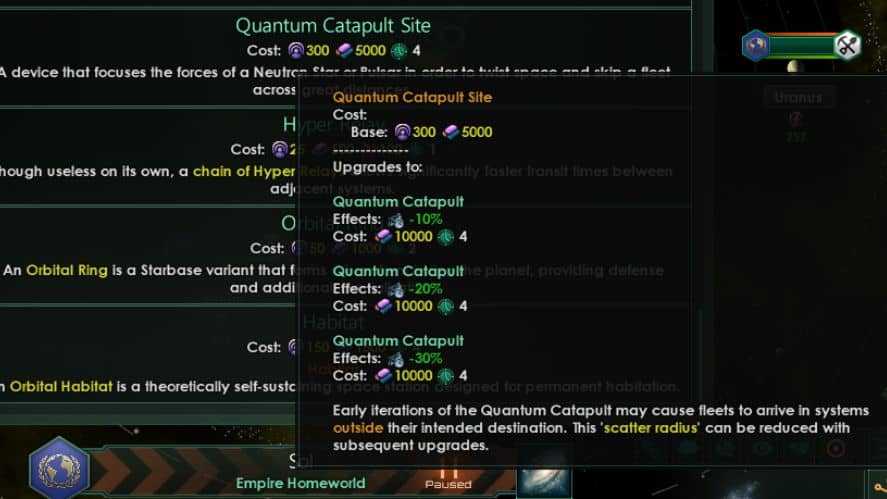
A much quicker and cheaper way to get a Quantum Catapult does exist in the game. During Empire creation, you have the option to select an origin story for your empire.
The Slingshot to the Stars origin will give you a ruined Quantum Catapult in your home system. You do not need to research to begin the reconstruction efforts of this catapult.
It will only cost 2500 alloys to repair, but it will take 10 years to finish. The restored catapult is as effective as a stage 2 normal catapult and only requires one upgrade to max out.
This upgrade will cost 15,000 alloys, bringing the full cost to 17,500 alloys.
What Does the Quantum Catapult do
Now that we know how to get a Quantum Catapult, what do we get for all our time and effort?
The Quantum Catapult gives your spaceships a brand new way to traverse the galaxy. Before getting across the galaxy could take years of in-game time. Now we have the potential to complete that journey in one jump.
Be warned, the further the jump, the more likely it is that things could go wrong. Fleets can get separated and even worse, go missing in action if they go too far off course. when using the catapult offensively, remember that while separated, your fleets are vulnerable to counterattacks.
This is why upgrading the catapult is super important. Each upgrade increases range and accuracy; mitigating but not eliminating the risk of mishaps.
How to use the Quantum Catapult.
Using the Quantum catapult is simple. First things first, we need to decide what fleets we want to send on a trip across the galaxy. Once you have decided, order them to move to the system containing the megastructure.
Once in the system, the “Catapult Fleet” option in the fleet UI will become selectable. It is next to the “Initiate Jump” button if you are struggling to find it. This option will only be selectable in the galaxy map, not in the system map.
After selecting the catapult fleet option, a target reticule will appear. You can then target which system you want to jump to.
You may notice the further away you target, the larger the reticule grows. This represents the potential margin of error when catapulting fleets. You must be aware that your fleets can land anywhere within that circle.
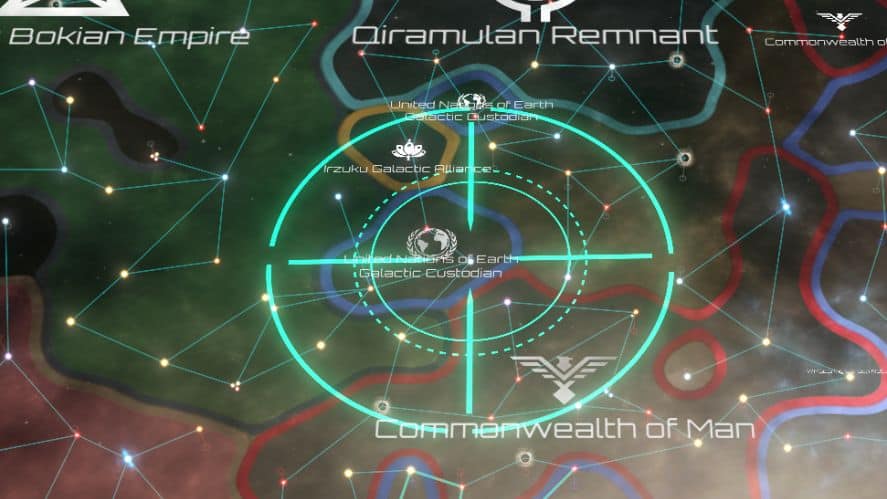
After selecting the target system, there is a wind-up time before your feet are launched. The time is determined by the catapult level, not the distance traveled.
After the wind-up, the fleets are launched and will land on or close to the target system, ready for orders.
Fleets fired by the catapult have a 33 percent modifier to their fire rate for 120 days. If you selected the Slingshot to the Stars Origin, this bonus is 50 percent.
This makes firing reinforcements into enemy territory not only cool but highly effective.
That is everything you need to know about how to use the Quantum Catapult in Stellaris.
If you have any questions or suggestions for this guide, please use the comment section below. Good luck shooting your fleets across the galaxy.
Source link

Report this post
Stellaris: How to Build Megastructures

Your changes have been saved
Email Is sent
Please verify your email address.
You’ve reached your account maximum for followed topics.
Stardew Valley: How To Get All Villager Weapons
10 best metroidvanias on pc, palworld: meteorite event, explained, quick links, base game megastructures: gateways, distant stars dlc megastructures: l-gates, utopia dlc megastructures: habitats, ring worlds, dyson spheres, science nexuses, sentry arrays, federations dlc megastructures: habitats, mega shipyards, megacorp dlc megastructures: matter decompressors, mega art installations, strategic coordination center, interstellar assembly, nemesis dlc megastructures: aetherophasic engine, overlord dlc megastructures: hyper relays, orbital rings, quantum catapults, ancient relics dlc: perfect mega art installation.
Your goal in Stellaris is to take your young, space-faring Empire to the highest heights possible! What does that look like for you? Complete control of the galaxy? Effective and solid partnerships with your neighbors? Destroying the galaxy entirely?
RELATED: Stellaris: Your Complete Guide To Terraforming
Whatever your plans are, there's a Megastructure to help you get there. Megastructures are special constructions that perform particular tasks on a massive scale. There are tons of them, and this guide helps you build every single one. For your ease of reading, we've divided them up based on the DLC that unlocks them.
The only Megastructures you can build for free are the Gateways, which allow you to transport ships instantly across the entire galaxy. All of the active Gateways in a galaxy are connected to one another, so you can use one Gateway to travel to any of them.
At the start of the game, a certain number of abandoned Gateways will spawn into the galaxy. If you use the 'Galactic Doorstep' Origin, one of those abandoned Gateways is guaranteed to be in the solar system where your Empire starts. To reactivate an abandoned Gateway, follow these steps:
- Make sure you've researched six Tier 1, Tier 2, and Tier 3 Technologies.
- Then, as soon as you discover an abandoned Gateway, there's a chance that you will receive the option to research the Physics Technology 'Gateway Activation.' Research it.
- Reactivate the Gateway after that research is complete by interacting with it. It will cost 6,000 Energy Credits, 2,500 Alloys, and take 2 years.
- When the Gateway has been reactivated, it will cause one random abandoned Gateway somewhere else in the universe to reactivate, too, so you can travel through it.
Now that you've reactivated a Gateway, you can build your own new ones! You'll want to be careful with how and where you place them, since they're as useful to your enemies as they are to you.
- Make sure to research 'Mega-Engineering' Technology and complete six Tier 1, Tier 2, Tier 3, and Tier 4 Technologies.
- Research the Physics Technology 'Gateway Construction,' which will appear once those prior technologies have been researched.
- Once that is complete, you'll need to prompt a Construction Ship to build the construction site for the gateway wherever you want it to go. This process costs 2,500 Alloys, 75 Influence, and takes 3 years to finish.
- Finally, interact with the Gateway's construction site to upgrade it into an activated Gateway. This will cost you 6,000 Energy Credits and 2,500 Alloys and take 3 years.
You cannot place a Gateway within the system's gravity well (basically, it needs to be pretty far from the sun).
L-Gates operate a lot like Gateways, in that they let you travel vast distances in a ridiculously short amount of time. However, instead of connecting to all the other L-Gates in the galaxy, all L-Gates travel to the same place: a little system outside the galaxy, known as the Terminal Egress. From there, you can enter one of the other L-Gates to another part of the galaxy. It's essentially the Gateway System with an extra step. However, unlike Gateways, you cannot build more L-Gates.
L-Gates do not allow you to travel to Gateways, or vice versa.
RELATED: Stellaris: The Best Cheats
Dyson Sphere
A Dyson Sphere is a multi-stage Megastructure. Only one multi-stage Megastructure can be built per system and only one multi-stage Megastructure can be constructed or upgraded at a time. All multi-stage Megastructures can only be built once per Empire, except for the Ring World.
The Dyson Sphere is an enormous sphere that encompasses a sun to harvest all of its power. The surrounding planets, not receiving any light anymore, become barren worlds. However, you'll be able to harvest an incredible amount of Energy Credits! Just be sure not to build it in a system with habitable planets.
Before you can build a Dyson Sphere, you must have...
- Researched the 'Mega-Engineering' Technology
- Taken the 'Galactic Wonders' Ascension Perk
- Researched the 'Dyson Sphere' Technology
Once that's done, you'll build the Dyson Sphere in five stages. Send a construction ship to build the Site around the Star of your choosing to start the process.
Science Nexus
A Science Nexus is a multi-stage Megastructure. Only one multi-stage Megastructure can be built per system and only one multi-stage Megastructure can be constructed or upgraded at a time. All multi-stage Megastructures can only be built once per Empire, except for the Ring World.
The Science Nexus is a space station focused on research. It does wonders for making you the smartest, most superior Empire in the galaxy!
Before you can build a Science Nexus, you must have...
- Researched the 'Science Nexus' Technology
Once you've researched those, you can build a Science Nexus in three stages. Start the process by building the Site with a Construction Ship.
Habitats are space stations where citizens of your Empire can live. They can be built to orbit around any planet, but they'll earn an extra district type if they're built around a planet with a resource (like minerals, alloys, and exotic gases).
There are three levels of Habitats; to unlock the ability to create and then upgrade the Habitat, you'll need to research certain Engineering Technologies.
Once you've researched the initial Technology. Habitats can be built by a Construction Ship in almost any system!
You can't build a Habitat to orbit around a sun, a black hole, an asteroid, or a moon.
Sentry Array
A Sentry Array is a multi-stage Megastructure. Only one multi-stage Megastructure can be built per system and only one multi-stage Megastructure can be constructed or upgraded at a time. All multi-stage Megastructures can only be built once per Empire, except for the Ring World.
The Sentry Array is a lot like a Listening Post that you might build on a Starbase, but with a much, much bigger range. The bigger your sensor range, the further away you can detect ships and hyperlanes.
Before you can build a Sentry Array, you must have...
- Researched the 'Sentry Array' Technology
Once that's done, you'll build the Sentry Array in four stages. Send a construction ship to build the Site around the Star of your choosing to start the process.
Since space creatures like Ancient Mining Drones and Space Amoeba only spawn in systems out of your detection, you will effectively stop them from respawning by completing the Sentry Array.
Ring Worlds
A Ring World is a multi-stage Megastructure. Only one multi-stage Megastructure can be built per system and only one multi-stage Megastructure can be constructed or upgraded at a time. All multi-stage Megastructures can only be built once per Empire, except for the Ring World.
Ring Worlds are basically artificial planets on a much bigger scale than Habitats. They are built around stars in order to harvest their energy. This is the only type of multi-stage Megastructure you can build more than once. When it's done, all the other planets are taken out of the system.
Before you can build a Ring World, you must have...
- Researched the 'Ring World' Technology
Now you can start building a Ring World! It'll take place in five stages and start by building the Site around a star with a Construction Ship.
Ring Worlds cannot be built around black holes, in systems with more than one star, in systems with no planets or asteroids at all, or in systems with habitable planets or habitats.
RELATED: Everything We Wish We Knew Before We Started Stellaris
Habitats are one of the only Megastructure to be available in two DLCs. If the Utopia DLC is owned, Habitats can be built by any race. If only the Federations DLC is owned, then Habitats are only available to species with the 'Void Dwellers' Origin.
Refer to the Habitats section of the Utopia DLC for details on how to build them.
Mega Shipyard
A Mega Shipyard is a multi-stage Megastructure. Only one multi-stage Megastructure can be built per system and only one multi-stage Megastructure can be constructed or upgraded at a time. All multi-stage Megastructures can only be built once per Empire, except for the Ring World.
The Mega Shipyard can build ships itself, but it also doubles the build speed of all shipyards across your entire Empire. Obviously, this is an incredible military advantage.
Before you can build a Mega Shipyard, you must have...
- Researched the 'Mega Shipyard' Technology
Once that's done, you can build a Mega Shipyard in stages. As always, send a Construction Ship to build the initial site.
When the Mega Shipyard is completed, all ships will start with 100 experience and you can build new Titan-, Colossus-, and Juggernaut-class ships.
RELATED: Stellaris: How To Defeat The Unbidden
Matter Decompressor
A Matter Decompressor is a multi-stage Megastructure. Only one multi-stage Megastructure can be built per system and only one multi-stage Megastructure can be constructed or upgraded at a time. All multi-stage Megastructures can only be built once per Empire, except for the Ring World.
Matter Decompressors are built around black holes and drain minerals from it. The theory is that all the materials that the black hole has sucked in over the centuries are still there, just in an incredibly compressed state.
Before you can build a Matter Decompressor, you must have...
- Researched the 'Matter Decompressor' Technology
Pick a black hole to build your Matter Decompresor around, then send a Construction site to build the initial site.
You cannot build a Matter Decompressor in a system with any habitable planets or anomalies.
Mega Art Installation
A Mega Art Installation is a multi-stage Megastructure. Only one multi-stage Megastructure can be built per system and only one multi-stage Megastructure can be constructed or upgraded at a time. All multi-stage Megastructures can only be built once per Empire, except for the Ring World.
The Mega Art Installation is basically exactly what you expect: a big art gallery! It provides a lot of jobs and produces tons of Amenities and Unity, which is especially helpful for the Machine Empires.
Before you can build a Mega Art Installation, you must have...
- Researched the 'Mega Art Installation' Technology
Build a Mega Art Installation wherever you like by sending a Construction Ship to set up the initial Site.
Strategic Coordination Center
A Strategic Coordination Center is a multi-stage Megastructure. Only one multi-stage Megastructure can be built per system and only one multi-stage Megastructure can be constructed or upgraded at a time. All multi-stage Megastructures can only be built once per Empire, except for the Ring World.
The Strategic Coordination Center allows you to take your military presence in space to the next level. It improves the speed you fly at, how many ships you can have, and more.
Before you can build a Strategic Coordination Center, you must have...
- Researched the 'Strategic Coordination Center' Technology
Next, start building your Strategic Coordination by sending a Construction Ship to set up the initial site.
Interstellar Assembly
An Interstellar Assembly is a multi-stage Megastructure. Only one multi-stage Megastructure can be built per system and only one multi-stage Megastructure can be constructed or upgraded at a time. All multi-stage Megastructures can only be built once per Empire, except for the Ring World.
The Interstellar Assembly is an official headquarters for the Galactic Community. Since your race provided this wonderful construction, you'll get huge diplomatic advantages, like extra envoys and increased opinion from other species.
Before you can build an Interstellar Assembly, you must have...
- Researched the 'Interstellar Assembly' Technology
Build your new Interstellar Assembly like you do any other multi-stage Megastructure: starting with a site built by a Construction Ship.
Aetherophasic Engine
The Nemesis DLC allows players to take a new Ascension Perk: 'Become the Crisis.' Rather than the galaxy facing a unique crisis at the end of the game, you're facing the rest of the galaxy. If you take that Ascension Perk and complete the related special projects to get to the final Crisis Level, a Aetherophasic Engine appears in the capital system of your Empire .
Complete the Aetherophasic Engine and completely destroy the galaxy with it! There are five stages in total to completing this structure, each one requiring incredible amounts of Dark Matter.
RELATED: Stellaris: Cybernetic Ascension Guide
Hyper Relays
Hyper Relays are built in solar systems to decrease the length of time you spend traveling across that systems. The idea is to build many Hyper Relays across the paths in your Empire that you often traverse, thus significantly decreasing the time it takes to move ships.
Before building a Hyper Relay, you must have...
- 'Hyperspace Travel'
- 'Hyperlane Breach Points'
- 'Hyper Relays'
- Access to Rare Crystals (whether through the Galactic Market or your own production)
Use the 'Build Megastructure' in a Construction Ship's menu to build a Hyper Relay. It will cost 25 Influence, 500 Alloys, and 100 Rare Crystals.
Orbital Rings
Orbital Rings are to planets what Starbases are to suns. They provide bonuses, protection, resources, and much more.
In order to start building Orbital Rings, make sure you have researched the following Technologies:
- 'Starhold'
- 'Galactic Administration'
- 'Ceramo-Metal Infrastructure'
- 'Orbital Rings'
Then, use a Construction Ship to add Orbital Rings to planets! They can even be upgraded further down the line.
Once complete, you'll be able to add your own modules and buildings to the Orbital Ring.
Quantum Catapult
A Quantum Catapult is a multi-stage Megastructure. Only one multi-stage Megastructure can be built per system and only one multi-stage Megastructure can be constructed or upgraded at a time. All multi-stage Megastructures can only be built once per Empire, except for the Ring World.
Can you guess what the Quantum Catapult is flinging? Why, your ships, of course! When you use the Quantum Catapult, you'll be able to throw a fleet of ships across the galaxy (up to a certain range that increases as the Catapult is upgraded). The downside is that you'll lose access to them until they get to their destination.
Before you can build a Quantum Catapult, you must have...
- Researched the 'Quantum Catapult' Technology
Once that's done, pick the best spot for your Quantum Catapult to start throwing from. Keep your range in mind! A Construction Ship can build the initial site.
Perfect Mega Art Installation
The Ancient Relics DLC allows you to perfect the Mega Art Installations you can build with the MegaCorp DLC. There are no special steps other than just having that DLC.
You need to build a Mega Art Installation and upgrade it to the third Stage before perfecting it in the fourth Stage.
NEXT: Stellaris: Everything You Need To Know About Espionage
- Indie Games
Let your curiosity lead the way:
Apply Today
- Arts & Sciences
- Graduate Studies in A&S
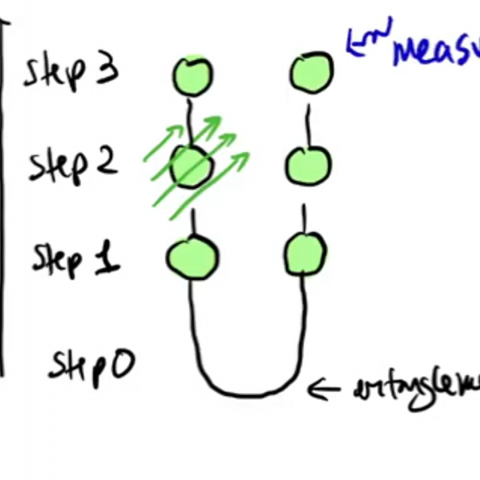
Quantum Advantage
Quantum advantage: building 'time-traveling' quantum sensors.
In a paper published in Physical Review Letters, scientists at WashU and elsewhere demonstrate a new type of quantum sensor that leverages quantum entanglement to make time traveling detectors.
The idea of time travel has dazzled sci-fi enthusiasts for years. Science tells us that traveling to the future is technically feasible, at least if you’re willing to go near the speed of light, but going back in time is a no-go. But what if scientists could leverage the advantages of quantum physics to uncover data about complex systems that happened in the past? New research indicates that this premise may not be that far-fetched. In a new paper published June 27, 2024, in Physical Review Letters, Kater Murch , the Charles M. Hohenberg Professor of Physics and Director of the Center for Quantum Leaps at Washington University in St. Louis, and colleagues Nicole Yunger Halpern at NIST and David Arvidsson-Shukur at the University of Cambridge demonstrate a new type of quantum sensor that leverages quantum entanglement to make time- traveling detectors.

Murch describes this concept as analogous to being able to send a telescope back in time to capture a shooting star that you saw out of the corner of your eye. In the everyday world, this idea is a non-starter. But in the mysterious and enigmatic land of quantum physics, there may be a way to circumvent the rules. This is thanks to a property of entangled quantum sensors that Murch refers to as “hindsight.”
The process begins with entanglement of two quantum particles in a quantum singlet state—in other words, two qubits with opposite spin—so that no matter what direction you consider, the spins point in opposing directions. From there, one of the qubits—the “probe,” as Murch calls it—is subjected to a magnetic field that causes it to rotate.
The next step is where the proverbial magic happens. When the ancillary qubit (the one not used as the probe in the experiment) is measured, the properties of entanglement effectively send its quantum state (i.e. spin) “back in time” to the other qubit in the pair. This takes us back to the second step in the process, where the magnetic field rotated the “probe qubit”, and it is where the real advantage of hindsight comes in.
Under usual circumstances for this kind of experiment, where the rotation of a spin is used to measure the size of a magnetic field, there is a one-in-three chance that the measurement will fail. This is because when the magnetic field interacts with the qubit along the x-, y-, or z-axis, if it is parallel or antiparallel to the direction of spin, the results will be nullified–there will be no rotation to measure. Under normal conditions, when the magnetic field is unknown, scientists would have to guess along which direction to prepare the spin, leading to the one-third possibility of failure. The beauty of hindsight is that it allows experimenters to set the best direction for the spin—in hindsight—through time travel.
Einstein once referred to quantum entanglement as “spooky action at a distance.” Perhaps the spookiest part about entanglement is that we can consider entangled particle pairs as being the very same particle, going both forward and backwards in time. That gives quantum scientists creative new ways to build better sensors—in particular ones that you can effectively send backwards in time. There are a number of potential applications for these kinds of sensors, from detecting astronomical phenomena to the aforementioned advantage gained in studying magnetic fields, and more will surely come into focus as the concept is developed further.
in the news:

Tikhonov wins NSF CAREER award

Nowak named Associate Director of the McDonnell Center for the Space Sciences
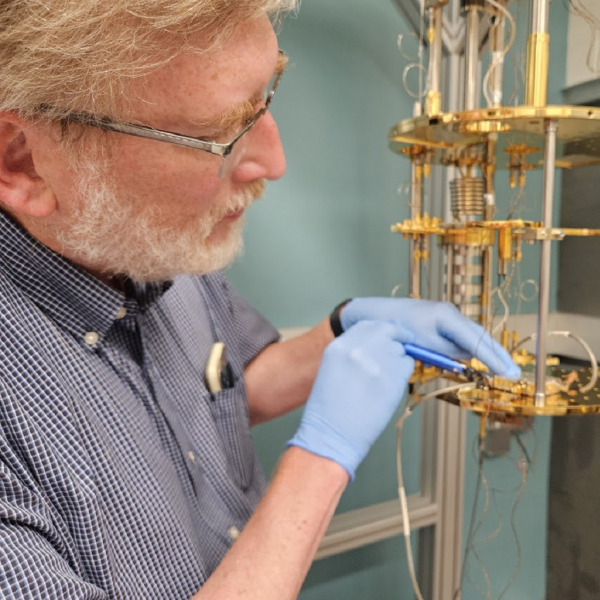
Breaking the cold barrier: searching for the nature of dark matter with new dilution refrigerator

Uncovering new worlds with Professor Tansu Daylan

IMAGES
VIDEO
COMMENTS
Using the catapult involves a few steps. Put your desired fleet in the catapult, select it, then open the galaxy view. Click the "Catapult Fleet" option from the icon bar. It's near the jump ...
Once you have the Quantum Catapult online, using it is easy. Simply move a fleet into the system with the Catapult - anywhere will do - and click the Catapult Fleet icon in the Fleet Manager window. This produces a targeting cursor which you can use to designate a target for your fleet. If the target is valid it will turn green, and then you ...
Right clicking on the Quantum Catapult has the following options - Enter Orbit, or Travel through Quantum Catapult - but its X out - the message says no known destination. Left click just has a upgrade option to further upgrade the quantum catapult - time that a ship remains in transit. #2. Triage May 13, 2022 @ 6:46pm.
The Quantum Catapult is one of the cheapest Megastructures to build in Stellaris, ... Once the Site is completed, players can upgrade it through four stages, each of which costs 10,000 Alloys.
Found it, had same question. Click a fleet in the partially/fully built quantum catapult system, look for button row above leader portrait, there's a new button that looks like a ship with an arrow pointing to the top right, next to the button that has the ship and the binoculars all the way on the right.
Using the Quantum catapult is simple. First things first, we need to decide what fleets we want to send on a trip across the galaxy. Once you have decided, order them to move to the system containing the megastructure. Once in the system, the "Catapult Fleet" option in the fleet UI will become selectable.
How to Use Quantum Catapults in Stellaris. Firstly, you need to launch the game with the Overlords DLC in which they were introduced. Now although Slingshot to the Stars Origin gives it to you from the get-go, you can also choose to build a Quantum Catapult around a Neutron Star (Pulsar) for 300 Influence and 5000 Alloys.
In this short, we use our quantum catapult to attempt to fend off an unbidden invasion. We also test out the quantum catapults powerup with astral threads fr...
The Quantum Catapult stands as one of Stellaris' most cost-effective Megastructures, offering players an opportunity to explore, colonize, or invade distant star systems within the game. Stellaris' Overlord DLC brought forth the Quantum Catapult, a groundbreaking Megastructure that enables players to overcome any obstacle, expanding their empire and exploring new…
To use a Quantum Catapult first move your fleets into the same system as the Quantum Catapult. Go to Galaxy View and select your fleets. A targeting reticule appears. Place it where you want your fleet to go and if it's green, click on the destination. After a warm-up period the Catapult will "slingshot" your fleets, hopefully somewhat ...
Gateways allow travel to any other gateway instantly, so long as the borders are open and the destination is not controlled by an enemy empire. ... such that claims and trade can be extended through them, however sectors do not extend through gateways. Dismantling a gateway costs 2500 Energy and takes 1 year. L-Gates. ... Quantum Catapult ...
Catapulting requires the Quantum Catapult technology and megastructure. It has the greatest distance of all direct travel methods and gives the fleet +33% Fire Rate for 4 months. However, there is a chance the fleet arrives in a nearby system rather than the targeted destination, indicated by a circle around the target.
Archived post. New comments cannot be posted and votes cannot be cast. The catapult command is in the ship's command list, next to the hyper-jump button. Put a fleet in the system. Select fleet. Go to map. There is now a button you can press on the fleet menu that opens the catapult interface.
Doesn't seem useful at all since it becomes available only after the entire galaxy is linked with hyper relays The game I'm currently playing is at around 2350 and I've already got a superhighway that reaches the entirety of the "civilized" galaxy, and the alien federation on the other side of galaxy have their own highway anyway
Large-scale travel to different universes is a daunting task. We must engineer a spacecraft that can not only pierce the fabric of spacetime but also survive the journey. ... This energy source generates power for ships through induced fission, but it also produces harmful nuclear waste. ... Quantum Catapult: 48000: 5
Using the Quantum catapult is simple. First things first, we need to decide what fleets we want to send on a trip across the galaxy. Once you have decided, order them to move to the system containing the megastructure. Once in the system, the "Catapult Fleet" option in the fleet UI will become selectable.
Great for exploring in peace and ambushing in war. Its neat and very useful sometimes, but its uses are pretty specific, and its an expensive investment. I think if you have a catapult and build lots of relays its sortof an alternative to gateways or something. The catapult and relays kinda feel like a low-key return to different ftl types.
The quantum catapult is more like midgame. I think it is meant as a deep strike tool, but simply too inaccurate. Beyond getting the achievements i see little point using them. Maybe later they make it more accurate to actually hit the enemy hard bypassing defenses. Now that i think about it there is one very specific use against player.
L-Gates operate a lot like Gateways, in that they let you travel vast distances in a ridiculously short amount of time.However, instead of connecting to all the other L-Gates in the galaxy, all L-Gates travel to the same place: a little system outside the galaxy, known as the Terminal Egress. From there, you can enter one of the other L-Gates to another part of the galaxy.
The quantum catapult works by reversing the polarity of the subatomic nucleus within the atoms of solar radiation. A flux capacitor within each quantum coil of the hull fluxes the tachyons to the point of fusion instability, thereby allowing the gamma emissions to create an inverse propulsion into the hyperdrive of the ship.
The idea of time travel has dazzled sci-fi enthusiasts for years. Science tells us that traveling to the future is technically feasible, at least if you're willing to go near the speed of light, but going back in time is a no-go. But what if scientists could leverage the advantages of quantum physics to uncover data about complex systems that happened in the past? New research indicates that ...
Supposedly this is also why it gives debuff to the fleet after the jump, as the jump drive siphons energy away from other core systems to recharge. A possible explanation for the catapult, may be harnessing the high energy cosmic rays using the megastructure, and using them to "supercharge" the fleet's engines, to the point they can act as a ...
The quantum catapult is useless. Especially since it doesn't count toward galactic wonders, has limited range, costs 2500 alloys, and takes a fair bit of time to unlock. ... This Subreddit focuses specially on the JumpChain CYOA, where the 'Jumpers' travel across the multiverse visiting both fictional and original worlds in a series of ...